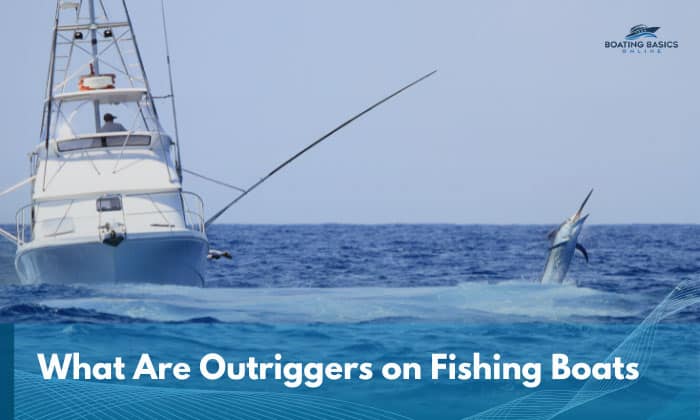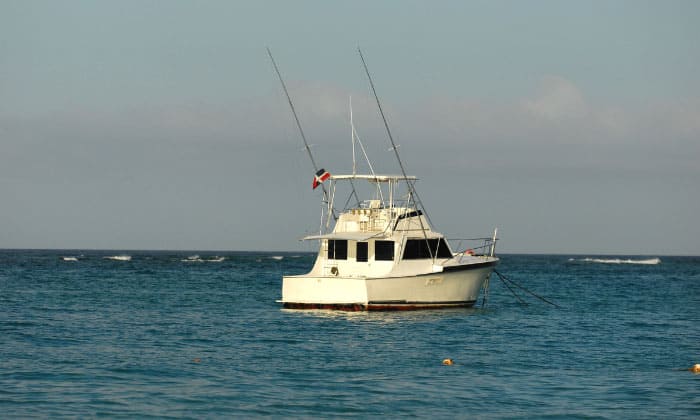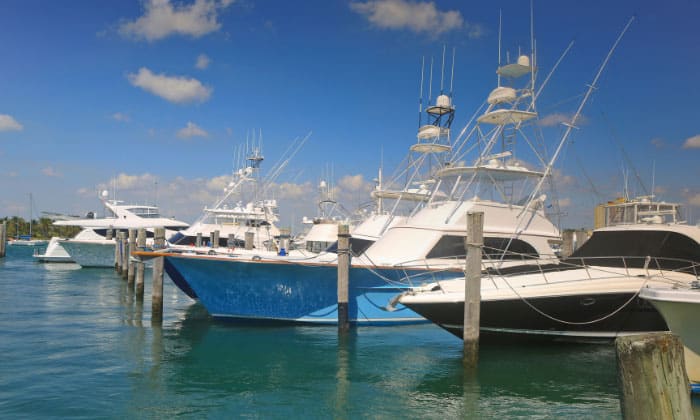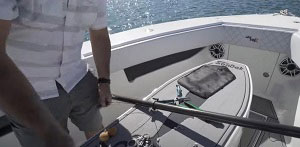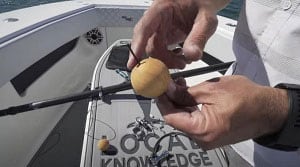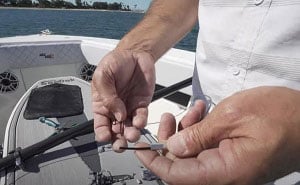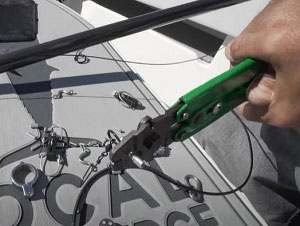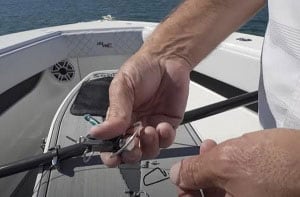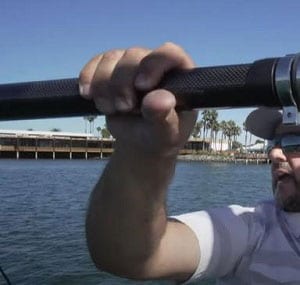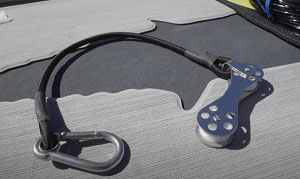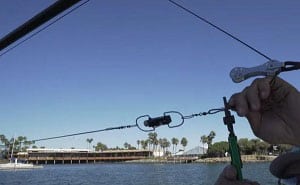I like the specificity of the question, “What are outriggers on fishing boats?” because outriggers on a boat as a whole serve multiple purposes. The most fundamental ones are to keep boats from capsizing and securing the mast.
In the context of modern fishing boats, they serve a more specialized purpose of improving your fishing experience directly. They do this by elevating and extending fishing lines (i.e., spread), which effectively boosts your chances of catching fish. They also help in preventing tangled baits while also aiding in stability.
Table of Contents
An in-Depth Look at Outriggers
How do outriggers work? Based on the answer above, some people may conclude that they’re quite similar to rod holders in that you don’t have to be holding the lines yourself to fish. Well, outriggers definitely hold fishing lines, but that’s arguably where most of the similarities end.
Just look at how they’re designed. They’re technically poles that can span over 35 feet. That said, the average length of outriggers for a boat used specifically for fishing is 20 feet.
Fishers attach or mount them to their vessels’ sides or, to be exact, the gunwale, so they’ll extend outward from the hull.
What Are the Purposes of Outriggers?
In the past, the term “outrigger” would only have been taken to mean floats attached to the side of the boats to help give them stability and help them handle stronger winds and rougher seas better.
If you’ve ever been to the Philippines, particularly the Visayas Islands, you’ll see plenty of native boats called bangka still utilizing them to great effect. As far as what does an outrigger do on a fundamental level, it’s really all about improving stability.
The same can be said for outriggers used for fishing. As they extend away from the hull, they serve to counterbalance the fishing lines’ weight.
The waves and wind already contribute to the amount of roll and sway the boat is subject to, and outriggers do well to mitigate them. That’s precisely why I’m all too willing to advocate outriggers for small boats.
However, better stability becomes a secondary benefit because most fishermen install them to (surprise, surprise!) catch more fish. This is why if you’ve been wondering, “Why do fishing boats have outriggers?” The root reason is pretty basic.
Overall, these facts are why if you’re not familiar with how outriggers work on a boat yet, I won’t be surprised if you mistake them for actual fishing rods!
Types of Outriggers for Fishing
1. Fixed
They’re fixed outriggers in such a way that they’re permanently mounted to the boat, and their lengths can’t be adjusted. They’re ideal for deep-sea trolling, but their fixed length can make it hard to pass under bridges due to clearance issues.
2. Telescoping
Also called tele-outriggers, these can be retracted or extended every time the need arises. While convenient and versatile, telescoping outriggers are high-maintenance and expensive.
How Do They Work?
First off, you always need to mount them first. Once that’s done, fishermen will start attaching the lines to the outriggers through release mechanisms. Afterward, the fishing lines will be fed through the circular loops or rollers called “guides” on the poles.
Once they’re properly set up, people can begin trolling—a type of fishing where the boat is often moving and drawing its fishing lines behind it. It’s really just a matter of waiting for fish to take the bait from here on.
Pros and Cons
Pros
- The long length of the outriggers allows you to increase your spread.
- It also helps you avoid your boat’s own wake, which tends to repel fish. It also means you’ll be able to see clearly should a bite happen.
- Aids in maintaining the vessel’s stability.
Cons
- While it does help increase your chance to catch fish, a poor outrigger fishing setup may lead to less-than-optimal conditions, such as line slack, especially if taglines aren’t used along with lures.
- We can’t deny they take up space, which a small boat hasn’t got a lot of.
- They can be quite expensive and only adds to the list of fishing contraptions that you need to maintain for your boat.
Summary of Benefits
- They help impart much-needed stability, especially if you frequently fish in open seas.
- One perk that highlights the value of commercial fishing boat outriggers is that they always improve your catch once properly set up because of the multiple lines you can deploy at the same time.
- They can immediately address line tangling issues that commonly happen if you can’t deploy baits beyond your boat’s wake.
Things to Consider When Choosing an Outrigger
1. Mounting Location
One of your first priorities should be clearly knowing where you’re going to mount and use outriggers. Naturally, they shouldn’t interfere with your other gadgets and accessories, and vice versa.
Some outrigger products make it clear that they can be mounted on cabin walls, besides the gunwales.
2. Boat Size
An outrigger’s length advantage can only get you so far. Too long, and they may actually make the stability worse for smaller vessels! On the flip side, if your vessel is too large and you pair it with fixed outriggers too tiny for its size, there won’t be much improvement in stability at all.
This is why you should always make sure that you’re using the most compatible outrigger system for your boat.
Generally, recommended outrigger sizes vary depending on where you mount them, but choosing one about 75% as long as your boat is a good start.
3. T-Top Hand Clearance
T-top height and size vary per boat. You should check its hand clearance (the distance between the gunwale and the T-top’s underside) to see if it would interfere with the outrigger’s deployment and stability perks.
4. Material
At best, you have three options to choose from: fiberglass, aluminum, and carbon fiber. They each have their own benefits and drawbacks:
- Aluminum is pretty heavy and corrosion-prone, but it’s flexible enough to handle strains.
- Fiberglass is lighter than aluminum but heavier than carbon fiber. It has the advantage of being corrosion-resistant and economical. Ultimately, though, fiberglass is only suitable for short outriggers.
- Carbon fiber strikes the perfect balance between lightweight and flexibility, although its high price may put some people off.
5. Fixed or Telescoping
Telescoping outriggers give the ready advantage of being compact and portable, while their fixed counterparts tend to be a heavier-duty option.
Tips to Increase Chances of Hooking Fish
- More often than not, keeping the baits apart already works wonders.
- Position your outriggers in such a way that you’ll be able to keep the bait near or right on the edge of the bait school even as you make tight turns.
- You really want to keep tangles from happening as much as possible. You can try spacing your lines further apart or wrapping one with something like Velcro.
Here are a few invaluable tips from a fishing maestro that I still abide by:
Steps to Install Outriggers for Fishing Boats
These steps assume that you have a rigging kit, such as the ones sold by Taco, so you have all the necessary tools to get an effective setup.
1. Run the fishing line through the guides or rollers up to the pole’s tip.
2. Afterward, pull the line back, then insert it through the stopper ball.
3. Slide the crimp on the line, then follow it with a swivel.
4. Slide the line through the crimp again to form a loop. Then use a crimping tool to tighten it.
5. Clip in the release mechanism. Position the release mechanism in such a way that the tension adjuster faces the top of the outrigger.
6. You can now mount the outrigger on your chosen location.
7. Mount the snubber so it will provide the tension the line needs to prevent it from bouncing around and tangling.
This depends a lot on the design and layout of your boat and how much tension you need on your lines. The general rule of thumb is to rig most lines tightly from the beginning since they tend to come loose over time.
8. You’ll need to hook the snubber to the end of the line connected to the release mechanism. Once you figure out the right tension, crimp the connection to retain how tense you want your line to be.
9. You can install your second line by repeating the steps.
Another good way to prevent tangling is to use taglines. Learn how to do that by watching this video:
Lastly, be sure to match the outriggers’ respective angles. Follow the recommended angle suggested by the manufacturer.
Conclusion
I hope I’ve given you the answer you need to your question, “What are outriggers on fishing boats?” On the whole, the mechanisms involved – from setup to once you get them rolling – are fascinating simply because you get to sit back and relax after you’ve set things up.
Even so, would you really skip an (almost) guaranteed banner day every time you head out? With the right rigging and knowledge of fishing spots in your area, I’m more than willing to bet on that.

“My intention from the first day establishing Boating Basics Online is to provide as much help as possible for boaters who want to experience a first safe and convenient trip. So feel free to join us and share your beautiful journeys to the sea!”

